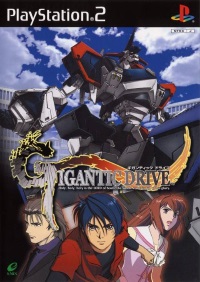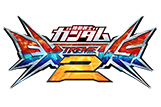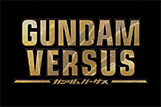Reviews: Gigantic Drive (8/10)
Posted on : 04-08-2014 | By : Cacophanus | In : Reviews
Hardware: PlayStation 2
4
 Throughout the sixties and seventies a certain genre of anime and manga ran rampant across Japan. It galvanised an entire generation, a generation that grew up to be game designers. They then went on to create games like Gigantic Drive. The genre was that of the mighty super robot and it is one of the oldest and most resilient facets of Japanese pop-culture (next to real robots of course). Gigantic Drive is a game that, literally, lets you control a “chogokin” from the ground up.
Throughout the sixties and seventies a certain genre of anime and manga ran rampant across Japan. It galvanised an entire generation, a generation that grew up to be game designers. They then went on to create games like Gigantic Drive. The genre was that of the mighty super robot and it is one of the oldest and most resilient facets of Japanese pop-culture (next to real robots of course). Gigantic Drive is a game that, literally, lets you control a “chogokin” from the ground up.
The story revolves around Earth being besieged by big nasty alien robots called the Volgara. To fight these invaders, we have created three rather large robots, whose sole purpose is to kick the posterior of multiple metal aliens back across the galaxy.
Studio Bones, of Cowboy Bebop fame, handles the story and character animation well. So it should come as no surprise that The character designs are also done by Toshiro Kawamoto. It is clear from the outset that the narrative focus is firmly tongue in cheek and, to anyone familiar with the conventions of the super robot genre, many of the references will give players the opportunity to crack a wry smile.
Within the main game, there are three characters and three “kizin” (read: super robots) to choose from. Each character has a different story and a few different missions, but the main game is essentially the same. Regardless of this, the kizin are where the fun is at.
Control of each of the kizin is undertaken from the perspective of whatever character you choose. This means that you are the camera and you will have to position yourself accordingly so as to achieve an optimum view. Views, and consequently controls, are changed through the use of the Select button.
This brings us onto the controls. Gigantic Drive has a unique take on camera work but the controls are equally special too. Moving your character about is pretty straightforward. Directions are undertaken by the left analogue/d-pad. First person view is toggled through the use of the X button. Grenades can be thrown, later on in the game admittedly, by using the Triangle button. Circle allows the character to fly, though the ability to fly (so as to achieve a satisfactory viewing position) is a tad surreal but necessary within the context of the game, whereas the Square button allows the player to enter some buildings and appear on the roof (without having to fly). It goes without saying that the shoulder buttons R1 and L1 allow your character to strafe. In any case, this is all elementary. The controlling of a kizin is a different matter entirely.
To give you a better idea of what this entails, you don’t just control the kizin itself; you can control each and every limb individually. In that, L1 moves the left leg forward, whereas L2 moves the left leg backward. The right leg is controlled through the use of the R1 and R2 buttons respectively. To walk you must input relevant L1, R1, L1, R1 etc. button commands. Turning is achieved by holding either L1 and L2 down (to turn left) and R1 and R2 (to turn right) and jumping is achieved by crouching (L2 and R2) and then inputting L1 and R1. Just getting your kizin to move is a pretty comprehensive experience. Combat is even more so.
Again, each arm is controlled separately. The left analogue stick controls the left arm and the right analogue stick controls the right arm. The movement is fluid and intuitive and, considering that your kizin’s arms are where most of the pain is dished out upon the Volgaran enemies, this concession will be very much appreciated by most players. That said, there is a great deal of depth left to the combat, whilst the controls maybe inclusive they are also very comprehensive. In that, the more you progress through the game the more money and consequently more attacks will become available. Learning these combos will help to defeat enemies quicker as well as with oodles of style.
In addition to all these punches, jabs and uppercuts there are various other weapons at your disposal. The Triangle button initiates an energy based beam attack, whereas the Circle button produces ordnance (normally in the form of guided missiles). These may sound useful but many of the more challenging opponents use something called the “Phantom System”. This means they can teleport away from enemy fire and appear behind your back, meaning that the game’s main combat focus remains strictly hand to hand.
Thankfully, in addition to the plethora of combos, hand to hand combat can be modified too. Depressing the L3 and R3 buttons makes your kizin’s hands change into weapons. These vary from drills and flamethrowers to electrified stunners and spewers of lightning death. All use your energy bar but the damage inflicted when used is far greater than with you kizin’s mere robotic hands.
Finally, the Square button allows each kizin to transform. Some directly transform, into either a tank or a plane, but others merely power up. The former are very useful and make traversing the sometimes complex environments quick and easy. Not to mention that controlling transforming robots is inherently cool anyway.
Set over 52 missions, Gigantic Drive is a sizeable game. The graphics are also utterly superb and they really give the player a sense of scale mixed with awesome power. Unfortunately, the size and diversity of the environments themselves are somewhat lacking. It is clear to see what the developers wanted to do. Have a Grand Theft Auto-esque cityscape, intermingled with the controlling of really big robots. The PlayStation 2 categorically cannot handle that, so sacrifices were clearly made. The robots remain intact but the vibrancy and diversity of the areas is rather bland. There aren’t enough pedestrians for one and the buildings lack any interactivity (apart from when you blow them up). Not to mention the opportunity lost of re-creating famous cities around the whole for the player to lay waste to. Admittedly, there is a rather small part of Tokyo and bits of Rome available to the player but what about London and/or Paris?
The music can also grate on occasion, simply due to its repetitiveness (more often than not the same track is used for almost all the missions). And for all the story’s witticisms, of which there are many, it does get in the way of killing big alien robots which is after all where the game’s focus lies. Finally, the learning curve is a tad redundant too. Whilst there are many enemies for the player to encounter, none tax the player all that much. Nor do they require use of specific combos in order to defeat them. This seems again like a wasted opportunity. Having multiple combos at your disposal but never needing to use them does seem an awful waste of good ideas.
Finally, the versus capability that the game offers is rather disappointing. Considering that the player needs access to a pretty comprehensive view, the screen management in “split screen versus” is rather lacking. The use of an iLink versus option would have been a nice addition but the mode is still flawed really.
Overall though, for all the game’s shortcomings, Gigantic Drive is a very special and interesting game. Considering the Remote Control Dandy lineage, having this updated is very much appreciated. As such, it is a defining mecha game and comes thoroughly recommended to all.
Tamashii: 8/10











isnt this Robot Alchemic Drive?
Yep but it was released first in Japan as Gigantic Drive (it’s also the version we played, hence why we reviewed it). This is also from our review archive btw 🙂
One of the most incredible mech games out there. The sense of scale and perspective is amazing.
[…] is still very similar to Sandlot’s older games (particularly Robotic Alchemic Drive or Gigantic Drive as it was known in […]